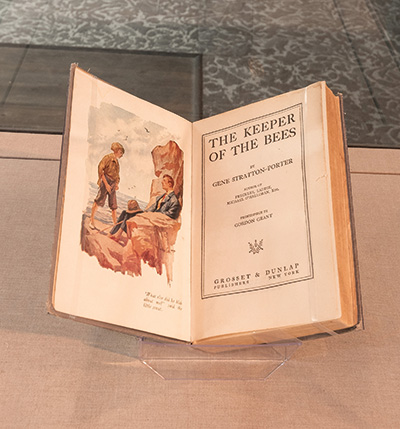New MSU Libraries exhibit builds a buzz around beekeeping
EAST LANSING, Mich., Oct. 2023 – A new exhibit exploring the relationship between beekeeping and bee culture in the United States is now on display at the Michigan State University Libraries Main Gallery through December 2023.
The exhibit “Building a Buzz: A History of Beekeeping in the United States” stems from the recent donation of Roger A. Hoopingarner’s bee book collection. The former MSU Department of Entomology Professor Emeritus was also a world-renowned apiary expert, and the donation of his materials has expanded the already impressive Bee Book Collection in the MSU Libraries Stephen O. Murray and Keelung Hong Special Collections. Curated by Life Sciences Librarian Jodi Coalter, the exhibit showcases materials detailing the importance of beekeeping and bee culture to both MSU and the United States, including valuable contributions made by Hoopingarner and other MSU beekeepers. Coalter also partnered with the Department of Entomology in the curation of this exhibit, specifically in showcasing the Hoopingarner collection materials. Also included are examples of how the department is using insects to build community and relationships between students during their time in the department. This year’s cohort is “Team Honey bee,” and the theme for the year is “Teamwork and Collaboration.”
Department of Entomology Chairperson Hannah Burrack shared her enthusiasm about the collaboration. “We are excited to partner with MSU Libraries to highlight the history of beekeeping in the U.S.,” Burrack said. “It’s particularly meaningful that papers and books from the collection of emeritus faculty member Roger Hoopingarner have been utilized to tell this story. We’re looking forward to welcoming members of the beekeeping community to view the exhibit during our reception on October 14.”
Bee enthusiasts will be pleased to find included in the exhibit Hoopingarner’s most recognizable work, “The Hive and the Honey Bee Revisited,” a 2014 annotated text that expands on another well-known book included in the exhibit, Lorenzo Langstroth’s “Langstroth on the Hive and the Honey Bee” (1853). The original text provided an introduction to the history of beekeeping and brought forth the idea of “bee space,” or the amount of space bees prefer between comb. Hoopingarner’s annotated version of the text follows in the footsteps of Langstroth’s work by showing both what has changed and what has endured in the history of beekeeping since its publication more than 150 years ago.
Coalter cited the significance of the Hoopingarner collection and other materials in the exhibit to the world of beekeeping and pollination in the U.S. “This exhibit shows how essential bees were to early colonists, how the science of beekeeping evolved over the centuries and how important beekeeping is to the university and the United States today,” she said. “As I was studying the history of beekeeping and the history of the apiaries here at MSU through the Hoopingarner collection, I realized how similar these two stories were, and how local history ties directly to national history. History is still being written — bees are just as important today as they were to early colonists in 1776.”
Notable items outside of the Hoopingarner collection include two editions of Charles Butler’s work “The Feminine Monarchie” (1623) and (1634). Butler’s seminal work was one of the first books to clearly state that beehives were led by female bees (queens) and also introduced the term “drones” for male bees. “American Entomology,” written by Thomas Say and published in 1824, is considered the first field guide of American insects. While previous texts typically included insects mostly found in Europe, Say’s book shifted the focus to a new and growing country full of equally new species to explore. Finally, the exhibit also features materials from distinguished MSU beekeepers, including Albert John “A. J.” Cook, Frank Benton and Ethbert “Bert” Martin. Cook taught at MSU and established the Collection of Insects at the MSU Department of Entomology in 1867; his classroom lectures were published as “The Manual of the Apiary” in 1880. Benton, a graduate of Michigan Agricultural College, became a U.S. Entomologist, working closely with beekeepers worldwide in pursuit of new bee subspecies; the Japanese translation of “The Honey Bee” (n.d.) on display comes from the Frank Benton Papers held at the University Archives & Historical Collections. Ethbert “Bert” Martin was an apiculturist at Michigan State University starting in 1950; “The Bee & Me” (n.d.), which he wrote to describe his beekeeping work to his children, is also on display from the UAHC.
A reception will be held in the gallery space on Saturday, October 14, from 6 p.m. to 8 p.m.
The MSU Libraries are at the center of academic life at Michigan State University, providing expertise, collections and infrastructure for discovery and creation. The Libraries facilitate connections that support research, teaching and learning in our local and global communities. The Libraries also promote equal access to information and spaces for all and lead meaningful initiatives in accessibility, diversity, equity and inclusion.

